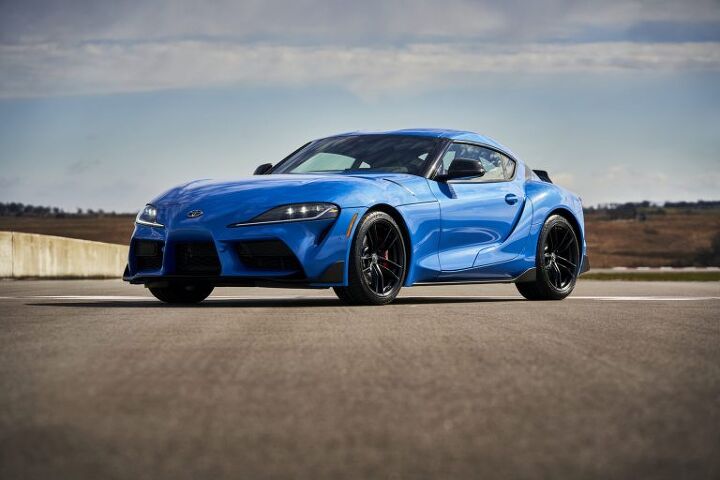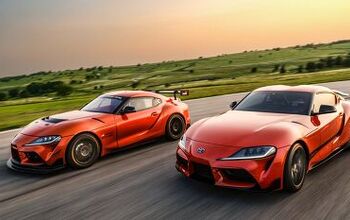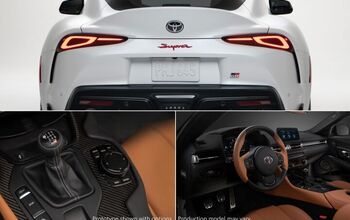Toyota Supra Finally Getting Manual Transmission

Toyota engineers have been fairly adamant that there would eventually be a manual version of the Supra sports coupe since its formal introduction in 2019. By February of 2020, chief engineer Tetsuya Tada even confirmed that the car has been tested extensively with a clutch and choose-your-own-adventure gearbox. But Toyota explained that the automaker opted against having one at launch due to a desire to lead with the model yielding the best specs on paper. Toyota was also fretting over customers modifying vehicles, claiming the eight-speed automatic could handle far more torque before giving into physics and dismantling itself.
However, the automaker has recently begun teasing the Supra with a three-pedal setup over social media, later stating that an-all new manual transmission was indeed on the way for the coupe. But why now?
The manufacturer hasn’t said anything officially. But we’re guessing the transmission was in the works for at least a year and the company felt like now was the best time to spill the beans. Nissan has already confirmed that the 400Z with as launching with a stick shift and it drops this August. Toyota may be worried that it’s about to be scooped by the competition and wants to assure future customers that it’ll be worth waiting for its manual-equipped entrant.
My assumption is that we probably won’t have to be on standby for long either. With BMW having introduced and then quickly eliminated manual variants of the Z4 sDrive 20i (equipped with the 2.0-liter B48 turbo I4) in select markets, Toyota has probably been working on something of its own since before that car launched.
BMW Z4s reviewed with the six-speed manual also haven’t gotten a lot of praise over the automatic. Most of the feedback (and there’s not been much since it hasn’t been a popular option) suggests that the gearshifts are pretty good. But there were a few complaints about the stiffness of the clutch and a nagging feeling that the automatic was probably the better choice for anyone seriously considering ownership. Still, for those seeking maximum engagement, there really isn’t any other option other than going for the third pedal and putting in a little work. But it might not have been good enough for Toyota, which would have assuredly tested the base 2.0-liter Supra using the same unit.
Despite being overwhelming similar automobiles in regard to their mechanical makeup, Toyota has tried to make the Supra into the more hardcore sports coupe — much in the same way the prior generation attempted to distance itself from the Lexus SC grand tourer. This could explain why the existing manual used on the Z4 never migrated over to Toyota’s parts pin. The Japanese company has repeatedly said the manual transmission represented a packaging issue for the Supra, likely indicating that it wanted something robust enough to cope with the 3.0-liter B58 turbo I6’s 382 horsepower and 340 foot-pounds of torque. The brand knows that it’s likely to be tuners and puritanical driving enthusiasts that’ll be optioning the most manual gearboxes — and they’ll be scoping out the 400-horsepower Nissan 400Z if the GR Supra cannot offer a manual yielding similar specs.
That theory has been supported by a statement from the automaker explaining that the forthcoming transmission was “engineered to offer enthusiasts something closer to the GAZOO Racing DNA.”
Toyota said it would be providing additional details in a few weeks. But we’ve already learned a few things over the weekend.
Unless the manual is to be locked into its own unique trim or Toyota has decided to ditch the standard black typography, it appears as though be-clutched Supras will have their name emblazoned in red on the rear deck lid. We also know what the pedals will look like thanks to the manufacturer providing photographs in advance of the formal announcement. Lastly, we’re probably going to see it on our market because Toyota USA has been teasing the new transmission in tandem with its European counterparts.
[Images: Toyota]

A staunch consumer advocate tracking industry trends and regulation. Before joining TTAC, Matt spent a decade working for marketing and research firms based in NYC. Clients included several of the world’s largest automakers, global tire brands, and aftermarket part suppliers. Dissatisfied with the corporate world and resentful of having to wear suits everyday, he pivoted to writing about cars. Since then, that man has become an ardent supporter of the right-to-repair movement, been interviewed on the auto industry by national radio broadcasts, driven more rental cars than anyone ever should, participated in amateur rallying events, and received the requisite minimum training as sanctioned by the SCCA. Handy with a wrench, Matt grew up surrounded by Detroit auto workers and managed to get a pizza delivery job before he was legally eligible. He later found himself driving box trucks through Manhattan, guaranteeing future sympathy for actual truckers. He continues to conduct research pertaining to the automotive sector as an independent contractor and has since moved back to his native Michigan, closer to where the cars are born. A contrarian, Matt claims to prefer understeer — stating that front and all-wheel drive vehicles cater best to his driving style.
More by Matt Posky
Latest Car Reviews
Read moreLatest Product Reviews
Read moreRecent Comments
- Slavuta Autonomous cars can be used by terrorists.
- W Conrad I'm not afraid of them, but they aren't needed for everyone or everywhere. Long haul and highway driving sure, but in the city, nope.
- Jalop1991 In a manner similar to PHEV being the correct answer, I declare RPVs to be the correct answer here.We're doing it with certain aircraft; why not with cars on the ground, using hardware and tools like Telsa's "FSD" or GM's "SuperCruise" as the base?Take the local Uber driver out of the car, and put him in a professional centralized environment from where he drives me around. The system and the individual car can have awareness as well as gates, but he's responsible for the driving.Put the tech into my car, and let me buy it as needed. I need someone else to drive me home; hit the button and voila, I've hired a driver for the moment. I don't want to drive 11 hours to my vacation spot; hire the remote pilot for that. When I get there, I have my car and he's still at his normal location, piloting cars for other people.The system would allow for driver rest period, like what's required for truckers, so I might end up with multiple people driving me to the coast. I don't care. And they don't have to be physically with me, therefore they can be way cheaper.Charge taxi-type per-mile rates. For long drives, offer per-trip rates. Offer subscriptions, including miles/hours. Whatever.(And for grins, dress the remote pilots all as Johnnie.)Start this out with big rigs. Take the trucker away from the long haul driving, and let him be there for emergencies and the short haul parts of the trip.And in a manner similar to PHEVs being discredited, I fully expect to be razzed for this brilliant idea (not unlike how Alan Kay wasn't recognized until many many years later for his Dynabook vision).
- B-BodyBuick84 Not afraid of AV's as I highly doubt they will ever be %100 viable for our roads. Stop-and-go downtown city or rush hour highway traffic? I can see that, but otherwise there's simply too many variables. Bad weather conditions, faded road lines or markings, reflective surfaces with glare, etc. There's also the issue of cultural norms. About a decade ago there was actually an online test called 'The Morality Machine' one could do online where you were in control of an AV and choose what action to take when a crash was inevitable. I think something like 2.5 million people across the world participated? For example, do you hit and most likely kill the elderly couple strolling across the crosswalk or crash the vehicle into a cement barrier and almost certainly cause the death of the vehicle occupants? What if it's a parent and child? In N. America 98% of people choose to hit the elderly couple and save themselves while in Asia, the exact opposite happened where 98% choose to hit the parent and child. Why? Cultural differences. Asia puts a lot of emphasis on respecting their elderly while N. America has a culture of 'save/ protect the children'. Are these AV's going to respect that culture? Is a VW Jetta or Buick Envision AV going to have different programming depending on whether it's sold in Canada or Taiwan? how's that going to effect legislation and legal battles when a crash inevitibly does happen? These are the true barriers to mass AV adoption, and in the 10 years since that test came out, there has been zero answers or progress on this matter. So no, I'm not afraid of AV's simply because with the exception of a few specific situations, most avenues are going to prove to be a dead-end for automakers.
- Mike Bradley Autonomous cars were developed in Silicon Valley. For new products there, the standard business plan is to put a barely-functioning product on the market right away and wait for the early-adopter customers to find the flaws. That's exactly what's happened. Detroit's plan is pretty much the opposite, but Detroit isn't developing this product. That's why dealers, for instance, haven't been trained in the cars.




































Comments
Join the conversation
"@Jeff S – What you say makes logical sense, but I think you’re forgetting one wild card. Government subsidies. Electric cars are very dependent on that, especially when we’re talking about getting them into the hands of the masses." how much does the US subsidize fossil fuels? 7-- billion, right? how much does the US subsidize electric vehicles?
The only Honda I would buy is a Supra.